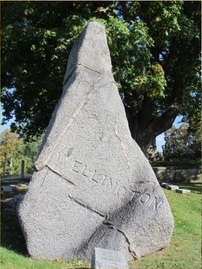Encyclopedia Dubuque
"Encyclopedia Dubuque is the online authority for all things Dubuque, written by the people who know the city best.”
Marshall Cohen—researcher and producer, CNN
Affiliated with the Local History Network of the State Historical Society of Iowa, and the Iowa Museum Association.
WELLINGTON, William E.: Difference between revisions
No edit summary |
No edit summary |
||
| Line 5: | Line 5: | ||
From 1863 until 1870 Wellington also acted as agent in Dubuque for different lines. During the [[CIVIL WAR]], the government transportation under his charge mounted to nearly $2,000,000. It was said he had only one voucher returned for correction. The amount was for four dollars; he had omitted his signature. (1) | From 1863 until 1870 Wellington also acted as agent in Dubuque for different lines. During the [[CIVIL WAR]], the government transportation under his charge mounted to nearly $2,000,000. It was said he had only one voucher returned for correction. The amount was for four dollars; he had omitted his signature. (1) | ||
Mr. Wellington built the first bulk barges for carrying grain on the river to New Orleans. He signed the first | Mr. Wellington built the first bulk barges for carrying grain on the river to New Orleans. He signed the first shipping bill of lading for cargo to Liverpool via New Orleans. In 1873, he was appointed by the Board of Directors to settle the affairs of the [[MERCHANTS' NATIONAL BANK]] and afterward bought the assets. Wellington also invested largely in land and eventually owned seventeen farms in Iowa. | ||
The unusual part of the Wellington story may be his obsession. He wanted to be buried under a huge boulder he could visualize. He would know it when he saw it; the stone could not be described. Wellington's search for a grave marker led to the story of Wellington's Boulder. (2) | The unusual part of the Wellington story may be his obsession. He wanted to be buried under a huge boulder he could visualize. He would know it when he saw it; the stone could not be described. Wellington's search for a grave marker led to the story of Wellington's Boulder. (2) | ||
| Line 25: | Line 25: | ||
[[Category: Business Leader]] | [[Category: Business Leader]] | ||
[[Category: Cemetery Marker]] | [[Category: Cemetery Marker]] | ||
[[Category: Firsts]] | |||
Revision as of 17:13, 21 December 2015
WELLINGTON, William E. (Arlington, MA, July 8, 1834--Dubuque, IA, June 6, 1916). Wellington arrived in Dubuque on March 29, 1855 nearly penniless. He began driving a dray; in 1856, he began steam boating. He ran a boat for George WEST and was with him as an agent until 1861 when he was appointed agent of the Northern Line and the Minnesota Packet Co. In the spring of 1863, he bought the steamer Pearl and during the season he and four others became joint owners of the boat. He provided all the management.
In November, 1863, Wellington and three other people formed and organized the NORTHWESTERN PACKET COMPANY. They then bought the stock in the Minnesota Packet Company and Wellington was appointed Superintendent and General Manager of the combined line. He ran the business until 1866 when the La Crosse & Minnesota Packet Company was acquired. He remained superintendent of the merged line until 1872, when he resigned.
From 1863 until 1870 Wellington also acted as agent in Dubuque for different lines. During the CIVIL WAR, the government transportation under his charge mounted to nearly $2,000,000. It was said he had only one voucher returned for correction. The amount was for four dollars; he had omitted his signature. (1)
Mr. Wellington built the first bulk barges for carrying grain on the river to New Orleans. He signed the first shipping bill of lading for cargo to Liverpool via New Orleans. In 1873, he was appointed by the Board of Directors to settle the affairs of the MERCHANTS' NATIONAL BANK and afterward bought the assets. Wellington also invested largely in land and eventually owned seventeen farms in Iowa.
The unusual part of the Wellington story may be his obsession. He wanted to be buried under a huge boulder he could visualize. He would know it when he saw it; the stone could not be described. Wellington's search for a grave marker led to the story of Wellington's Boulder. (2)
Wellington traveled through New England looking for the one-of-a-kind piece of granite only to return to Dubuque disappointed. It was near Mason City that he eventually found the stone of his dreams. In 1898 he hired a team of men to dig up the rock and load it onto a railroad flatcar. It weighed 28 tons and was 13 feet high.
At LINWOOD CEMETERY a foundation was prepared. Steel rails were built from the rock to the grave site and the stone was moved by a small rail car and then pulled to its final resting place. The entire process was supervised by Wellington. It is marked with only his name.
---
SOURCE:
1. William E. Wellington. Online: http://www.linwoodlegacies.org/william-e-wellington.html
2. Kruse, Len. "Wellington's Boulder," My Old Dubuque, Center for Dubuque History, Loras College, 2000, p. 193-194


